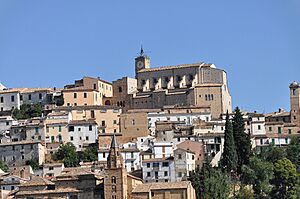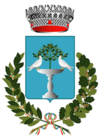Loreto Aprutino facts for kids
Quick facts for kids
Loreto Aprutino
|
||
|---|---|---|
| Comune di Loreto Aprutino | ||
 |
||
|
||
| Country | Italy | |
| Region | Abruzzo | |
| Province | Pescara (PE) | |
| Frazioni | Acquamorta, Belvedere, Bufarale, Burlesco, Camposacro, Cancelli, Cardito, Cartiera, Casafora, Castelluccio, Cecalupo, Collatuccio, Collecera, Collefreddo, Collepalma, Colle Carpini, Colle Cavaliere, Colle Ospedale, Cordano, Cupello, Farina, Ferrauto, Fiorano, Fiume, Fontemaggio, Fonte Murata, Fornace, Galliano, Gallo, Gomma, Lauriana, Madonna degli Angeli, Moscone, Muretto, Palazzo, Pallante, Pantano, Passo Cordone, Paterno, Piano della morte, Poggio Ragone, Pozzelle, Pretore, Pretosa, Remartello, Rielli, Rotacesta, Sablanico, Saletto, Salmacina, San Domenico, San Giovanni, San Pellegrino, San Quirico, Santa Maria in Piano, Scannella inferiore, Scannella Superiore, Scrizzetto, Sgariglia, Silvi, Valle Passeri, Valle Stella, Vicenne, Villa Erminia | |
| Area | ||
| • Total | 59 km2 (23 sq mi) | |
| Elevation | 307 m (1,007 ft) | |
| Population
(1 January 2013)
|
||
| • Total | 7,549 | |
| • Density | 127.9/km2 (331.4/sq mi) | |
| Demonym(s) | Loretesi, Lauretani, Rotesi | |
| Time zone | UTC+1 (CET) | |
| • Summer (DST) | UTC+2 (CEST) | |
| Postal code |
65014
|
|
| Dialing code | 085 | |
| Patron saint | San Zopito | |
| Saint day | Monday after Pentecost | |
Loreto Aprutino is a charming town located in the Province of Pescara. You can find it in the Abruzzo region of central Italy. In the local Abruzzese language, it's called Lûrëtë.
Contents
History of Loreto Aprutino
Early Settlements and Roman Times
Long ago, even before the Romans, people lived here! We know this because of old burial sites found nearby. These sites are called necropoleis.
Later, a group called the Vestini built a town. They named it Lauretum because lots of bay laurel trees grew there. This was after they had a conflict with the Romans.
Medieval Loreto: Castles and Monks
Around the year 1000, Benedictine monks built a castle and a special church (an abbey). The town grew around these buildings. In the 11th century, the Normans arrived. They made Loreto Aprutino an important place with its own county.
For many years, powerful families and nobles ruled Loreto Aprutino. These included families like the d'Aquino and the Medici. They ruled until the old system of feudalism ended. There's even an old book, called the Breve chronicon Lauretanum, that tells us about Loreto Aprutino in the 1200s.
Becoming "Loreto Aprutino"
In 1863, after Italy became one country, "Aprutino" was added to the town's name. This helped people tell it apart from other towns named Loreto in Italy.
During this time, the town became a lively place again. Arts and crafts were supported by wealthy people. One important person was Giacomo Acerbo. He helped create the Museum of Ceramics. The famous Castello Chiola, which you can see from far away, was also built around this time.
What Does Loreto Aprutino Produce?
Local Products and Farming
The main things Loreto Aprutino produces are olive oil and wine. These are very important for the local economy. Some well-known farms and estates here include Valentini, Talamonti, and Torre dei Beati.
What Can You See in Loreto Aprutino?
Exploring Castello Chiola
Castello Chiola was built on the site of a much older castle. Records from the 800s show that a castle was there even then! It was used as a prison and a military fort over the years.
Churches and Art
Another important building is the church of San Pietro Apostolo (St. Peter the Apostle). It was built in the 11th century. Inside, you'll see beautiful decorations, frescoes, and tiled floors. One special chapel is dedicated to St. Thomas Aquinas.
Just outside the town is the church of S. Maria in Piano. This church dates back to 1280. Its entrance has special writings praising the Virgin Mary. The walls and ceilings are covered with eight frescoes. These paintings, from the 1300s to the 1500s, show stories of saints. The family of St. Thomas Aquinas asked for these frescoes to be painted.
The "Bridge of Hair" Painting
The most famous painting in S. Maria in Piano is called Giudizio particolare delle anime. This means "Unusual punishment of souls." It was made using a special technique called Encaustic painting. This is where colors are mixed with melted wax.
The painting shows a scene of Divine judgment. It shows people trying to cross a bridge as thin as a human hair! Only good souls can cross without falling into a river of boiling tar. Those who make it are dressed in fine clothes and go up to the heavens.
Festivals and Celebrations
Festa di San Zopito
Every spring, on the first Monday after Pentecost, Loreto Aprutino celebrates the Festa di San Zopito. A parade is held in the town. A child, dressed in white and wearing a crown of flowers, rides a white ox. The ox is decorated with colorful ribbons and a red cloth with a picture of San Zopito. It's a very unique and traditional celebration!
See also
 In Spanish: Loreto Aprutino para niños
In Spanish: Loreto Aprutino para niños



